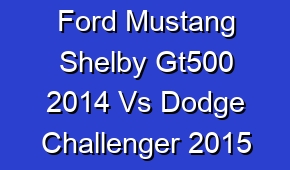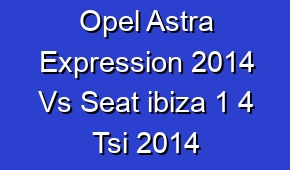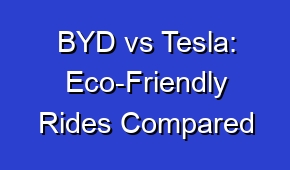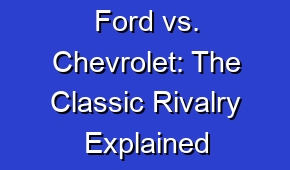Ford Mustang Shelby Gt500 2014 Vs Dodge Challenger 2015

Compare the Ford Mustang Shelby GT500 2014 and the Dodge Challenger 2015 to find out which muscle car reigns supreme. Discover their performance, design, and features in this head-to-head battle of American automotive legends.
| Feature | Ford Mustang Shelby GT500 2014 | Dodge Challenger 2015 |
|---|---|---|
| Engine | 5.8L V8 Supercharged | 6.4L V8 |
| Horsepower | 662 hp | 485 hp |
| Torque | 631 lb-ft | 475 lb-ft |
| Transmission | 6-speed manual | 6-speed manual or 8-speed automatic |
| Acceleration (0-60 mph) | 3.5 seconds | 4.2 seconds |
| Top Speed | 202 mph | 182 mph |
| Fuel Efficiency | 15 mpg city / 24 mpg highway | 14 mpg city / 23 mpg highway |
| Weight | 3,852 lbs | 4,082 lbs |
| Seating Capacity | 4 | 5 |
| Drive Type | Rear-wheel drive | Rear-wheel drive |
| Brakes | Brembo 6-piston front, 4-piston rear | Brembo 4-piston front, 4-piston rear |
| Suspension | Independent front and rear | Independent front and rear |
| Exhaust | Quad-tip dual exhaust | Dual exhaust |
| Infotainment System | Sync with MyFord Touch | Uconnect 5.0 |
| Audio System | Shaker Audio System | 6-speaker audio system |
| Bluetooth | Yes | Yes |
Engine
The Ford Mustang Shelby GT500 2014 is equipped with a powerful 5.8L V8 supercharged engine, while the Dodge Challenger 2015 has a 6.4L V8 engine. The Shelby GT500 offers more power and performance with its supercharged setup.
Horsepower
The Shelby GT500 boasts an impressive 662 horsepower, surpassing the Challenger’s 485 horsepower. This higher horsepower rating translates to greater acceleration and overall performance for the GT500.
Torque
With 631 lb-ft of torque, the Shelby GT500 delivers more twisting force than the Challenger’s 475 lb-ft. This allows for quicker acceleration and better low-end power.
Transmission
Both cars offer a 6-speed manual transmission, providing an engaging driving experience. However, the Challenger also offers an optional 8-speed automatic transmission for those seeking a more convenient shifting experience.
Acceleration (0-60 mph)
The Shelby GT500 accelerates from 0 to 60 mph in an impressive 3.5 seconds, outperforming the Challenger’s 4.2 seconds. This quick acceleration showcases the GT500’s high-performance capabilities.
Top Speed
The Shelby GT500 has a top speed of 202 mph, while the Challenger reaches a top speed of 182 mph. The GT500’s higher top speed demonstrates its superior performance and aerodynamics.
Fuel Efficiency
Both cars offer similar fuel efficiency ratings, with the Shelby GT500 achieving 15 mpg in the city and 24 mpg on the highway, and the Challenger getting 14 mpg in the city and 23 mpg on the highway.
Weight
The Shelby GT500 weighs 3,852 lbs, while the Challenger weighs slightly more at 4,082 lbs. The GT500’s lighter weight contributes to its agility and handling capabilities.
Seating Capacity
The Shelby GT500 and the Challenger both offer seating for four and five occupants respectively, providing ample space for passengers.
Drive Type
Both cars feature rear-wheel drive, which enhances their performance and handling characteristics, delivering power to the rear wheels for a more engaging driving experience.
Brakes
The Shelby GT500 is equipped with Brembo 6-piston front and 4-piston rear brakes, while the Challenger features Brembo 4-piston brakes on both the front and rear. These high-performance braking systems ensure effective stopping power.
Suspension
Both cars feature independent front and rear suspension systems, providing improved handling, stability, and a smoother ride over various road surfaces.
Exhaust
The Shelby GT500 comes with a quad-tip dual exhaust system, while the Challenger has a dual exhaust setup. These exhaust systems enhance the cars’ performance and produce a distinctive engine sound.
Infotainment System
The Shelby GT500 is equipped with the Sync with MyFord Touch infotainment system, while the Challenger features the Uconnect 5.0 system. These systems offer various features and connectivity options for entertainment and convenience.
Audio System
The Shelby GT500 comes with the Shaker Audio System, providing high-quality sound through its speakers. The Challenger, on the other hand, offers a standard 6-speaker audio system.
Bluetooth
Both cars are equipped with Bluetooth connectivity, allowing for hands-free calling and audio streaming from compatible devices.





















